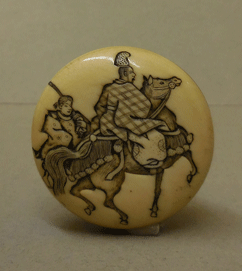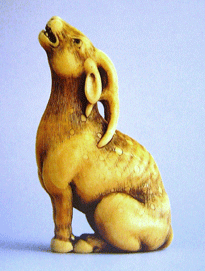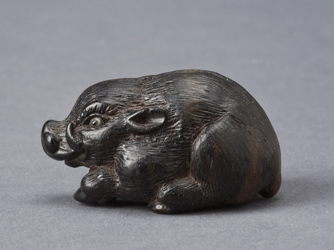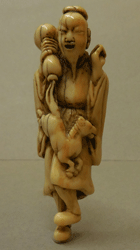|
NETSUKE: Japanese Art in Miniature
By Marsha Vargas Handley, President of the International Netsuke Society
Posted June 2015

Netsuke are truly unique to Japan. Because Japanese men had no pockets in their kimonos to carry personal items, a unique art form developed to allow them to suspend objects from their kimono sash (obi). One might say that the absence of pockets resulted in the invention of netsuke (figure 1). These utilitarian objects served as toggles to support tobacco pouches (tabakoire), medicine boxes (inro) and similar items suspended by a cord from the obi.
Exactly when netsuke came to be used in the present form is debated. In early Japanese history, bags for carrying flint for lighting fires were usually attached to a short sword and only in later periods were pouches attached to an object such as a netsuke. In 16th century paintings, actors in Kabuki theater are shown wearing a pouch and inro with a natural gourd functioning as a netsuke, which was attached to the obi by links. Gourds and sea shells were the most popular natural object to be used as a netsuke.
|

|
Fig. 1. Illustration of a man wearing a netsuke and inro.
|
The netsuke, whether a natural object such as a gourd or a carved figure, needed to be tied to a pouch or inro. Many of the more skilled carvers would use a natural opening, such as an area between the legs of a recumbent animal, but most netsuke will have two holes (himotoshi) that the cord would pass through to secure the object being carried to the netsuke. A genuine piece will have the attachment holes positioned in such a way that will allow the netsuke to sit on the top edge of the obi. Netsuke were not worn suspended like a pendant on a necklace, so when you see holes in the upper shoulders or top of a piece, it is modern and was never meant to be used as a netsuke.
|

|

|
|
Fig. 2. Manju-signed Kogyoku showing Narihira on horseback with attendant, 19th
century.
|
Fig. 3. Ivory stag, unsigned, 18th century, Kyoto.
|
Japan is surrounded by seas, and the Tokugawa-era shoguns prohibited foreigners and outside influences. This natural and enforced isolation allowed strong national characteristics to develop in the arts. In early Edo paintings we see that samurai and wealthy merchants used a simple round button-type object to tie onto their pouches. This form of netsuke is called a manju (figure 2). It is only in the late 17th and 18th centuries that three-dimensional netsuke (katabori) appeared in the form of figures or animals and became what people now think of as netsuke. Early netsuke tended to be large in size, with a wide range of subjects, like this wonderful ivory of a seated stag, its head raised, with mouth open braying (figure 3). This 18th century netsuke is unsigned, but from the style we can determine that it was carved in Kyoto. Because most of these early netsuke were not signed, we cannot identify the carver unless similar signed pieces have been found.
In Japan, wood predominated as the favorite material for sculpture, and this extended to netsuke. Today when people think of netsuke, they may immediately think of an ivory carving, but ivory was an expensive material imported during the Edo period and made up only a small percentage of netsuke.
Netsuke were made from many materials, including but not limited to wood, ivory, horn, bone, stag antler, metal and ceramic. Because the netsuke was to sit on the top edge of the obi, it was desirable to have a lightweight material so it did not pull down on the fabric of the obi. This made heavy materials such as stone not as popular or useful.
|

|

|
|
Fig. 4. Wood boar signed “Minko,”18th century.
|
Fig. 5. Ivory Chokwaro Sennin, unsigned, 18th century.
|
An example of a typical mid-18th century netsuke is of a recumbent boar by the artist Minko (1735-1812) who worked in Tsu. It is a compact piece carved from black persimmon wood with inlaid metal eyes and perhaps was commissioned by a person born in the Zodiac year of the boar (figure 4). The animals of the Zodiac were very popular in netsuke as were figures that represent legends and historic figures, such as this Chokwaro Sennin releasing his magic mule from its gourd (figure 5). A dog playing with an abalone (awabi) shell by the artist Okatori (ca. 1800) combines a Zodiac animal in a natural situation, making it very appealing (figure 6).
|
Fig. 6. Ivory dog with an awabi shell, signed “Okatori,” ca. 1800.
|
The rat as a Zodiac animal shows up frequently in netsuke, but if we look at the rat by Kaigyokusai shown in figure 7, we see that he is paired with a mallet. A collector would immediately recognize that this represents Daikoku, one of the Seven Lucky Gods, the god of wealth. The mallet identifies Daikoku as the subject because it is his primary attribute, which he uses to confer luck and wealth. A rat is his second attribute, perhaps because rats are drawn to extra food, which you would not have unless you were wealthy. The person wearing this netsuke perhaps wished for wealth and luck or was showing that he had already achieved it.
|
Fig. 7. Ivory rat, signed “Kaigyoku” (Kaigyokusai Masatsugu), mid-19th century.
|
An interesting and often overlooked type of netsuke is those that perform multiple functions, not only keeping the pouch or inro from slipping from the obi but also serving another purpose. “Ash pan” netsuke, for example, were often carried with a tobacco pouch, giving the wearer something to tap hot ash from the smoking pipe into—fire was a constant fear. A traveler might carry a compass and sundial netsuke so he would be able to tell the direction he was headed and when he might arrive. A traveling merchant might use a yatate netsuke that holds a miniature brush and ink .
As the wealthy businessman evolved in Japan so did the demand for netsuke as it was the fashion in the early 18th century to carry elaborate tobacco pouches and inro as a sign of success. The demand for netsuke continued to increase until the mid-19th century and only slowed with the Meiji period when Japan was opened to the West in 1868, and Western-style clothing with pockets became popular.
As the use of netsuke declined in Meiji Japan, the netsuke carvers, as well as the makers of lacquer inro, had to look to the West for support. Because these wonderful carvings were utilitarian objects that no longer had a purpose, many Japanese stopped acquiring them, but foreigners coming to the recently opened Japan were fascinated by these miniature sculptures. Historical records of one French antique dealer show that on one buying trip to Japan in the 1880s he collected more than 5,000 netsuke to send back to France.
In the early 20th century, there were a number of European collectors, and the early books on netsuke were written by Europeans. Today, the International Netsuke Society has a membership of more than 500 collectors, and it publishes a quarterly Journal, as well as holds biennial conferences for the purpose of studying netsuke and their related appurtenances. The next conference will be held in Baltimore, Maryland, September 4-8, 2015, with lectures, workshops and dealer exhibitions. For additional information about netsuke or the Society, please visit our website at www.netsuke.org.
---------------------------------------------------
Marsha Vargas Handley is a Senior Member of the American Society of Appraisers, accredited in Asian Art for more than 35 years. As President of the International Netsuke Society since 2009 and the owner of Xanadu Gallery in San Francisco specializing in fine Asian antiques, she has been involved with antique Japanese netsuke for more than 40 years. All photos are courtesy of the author.
|